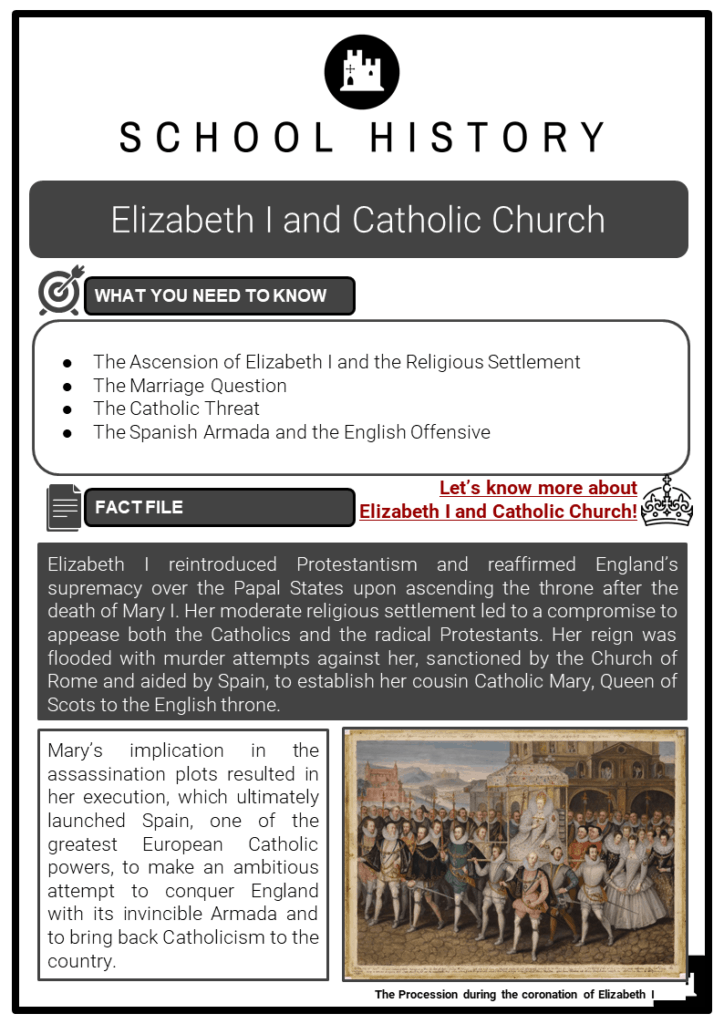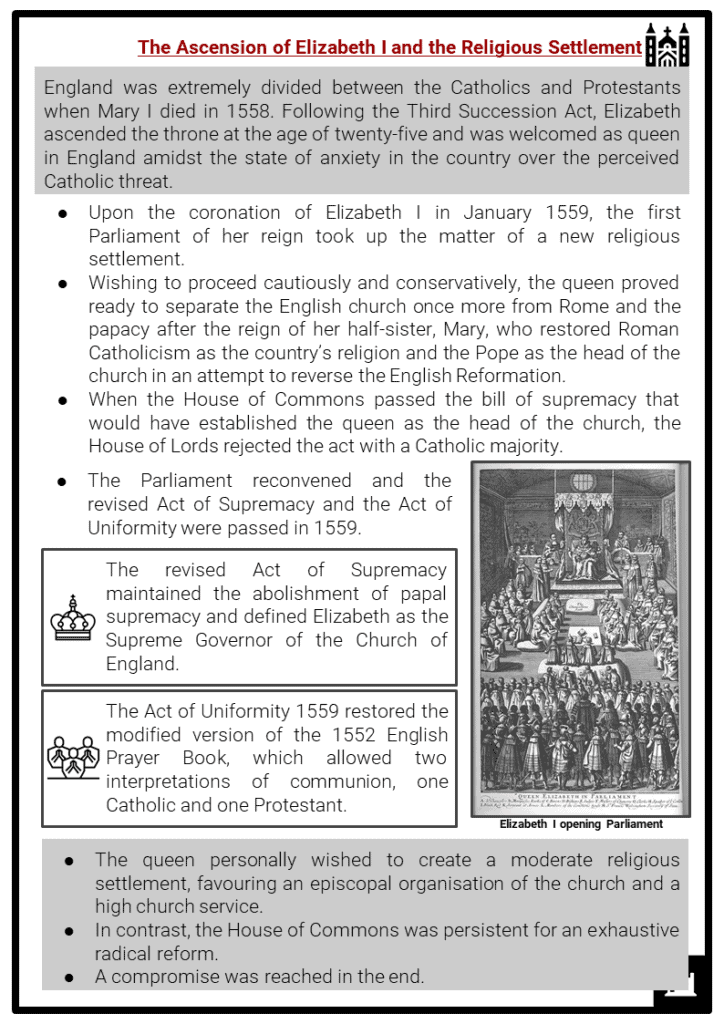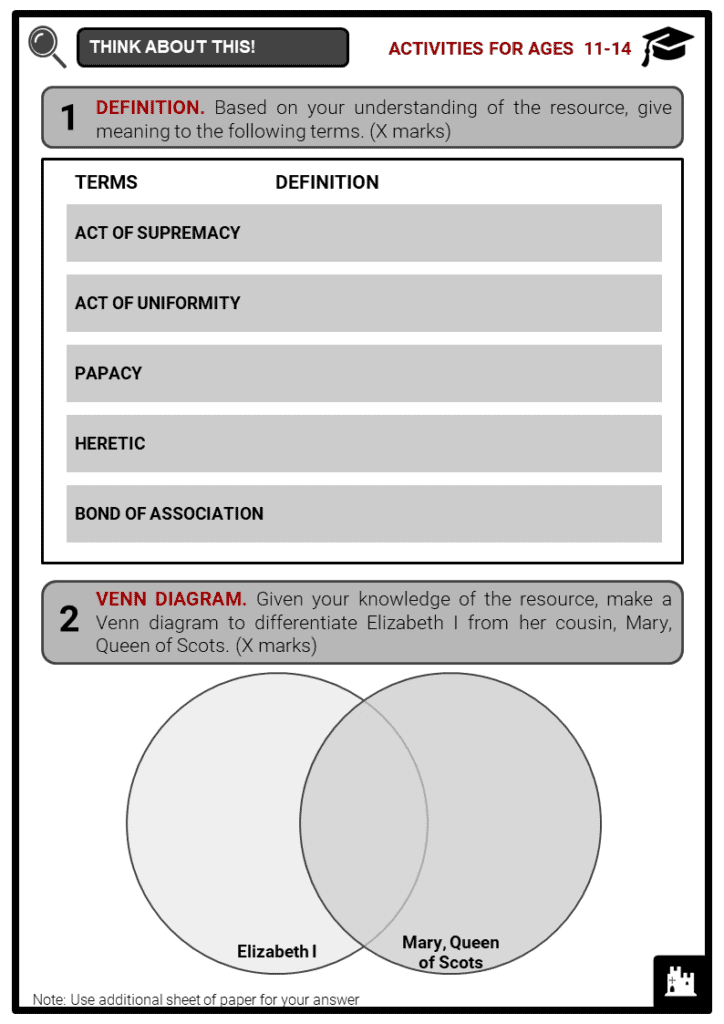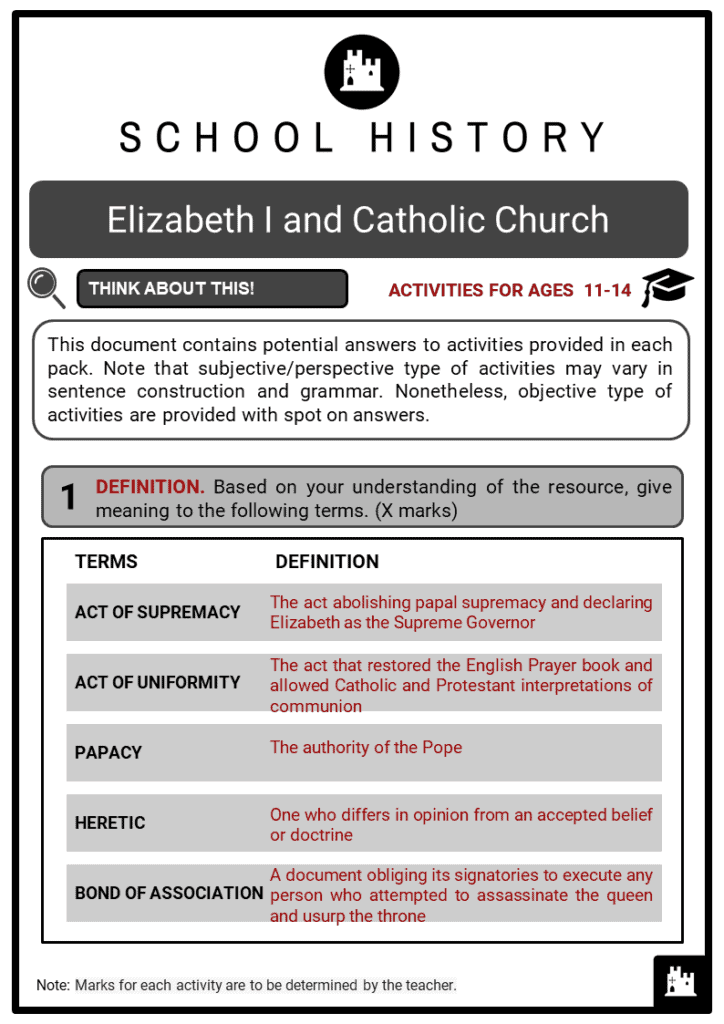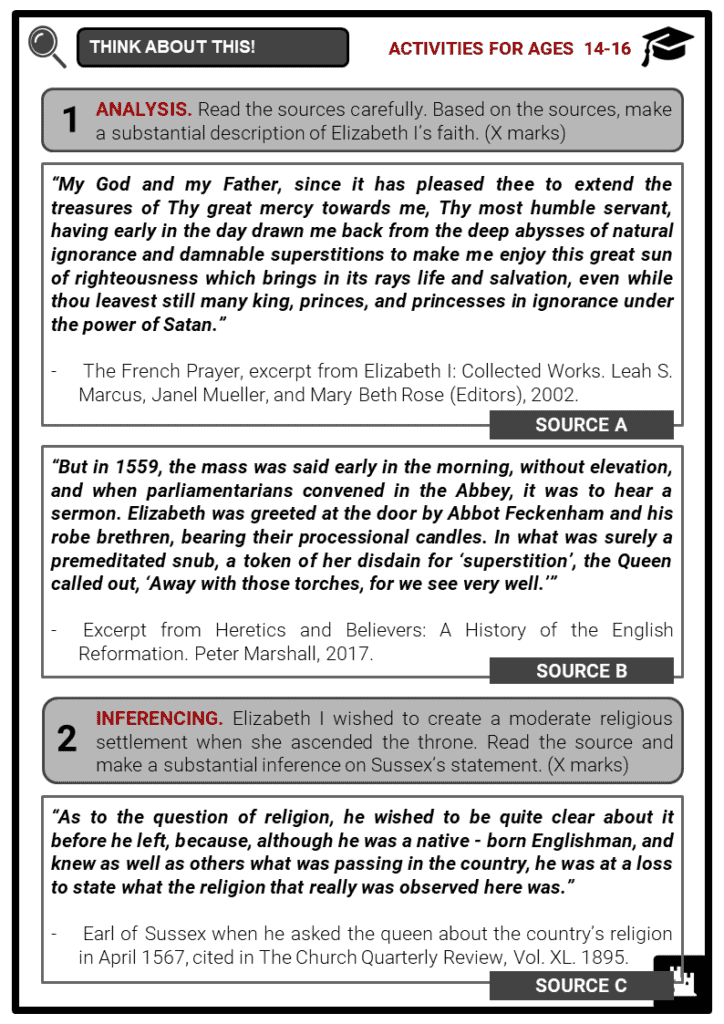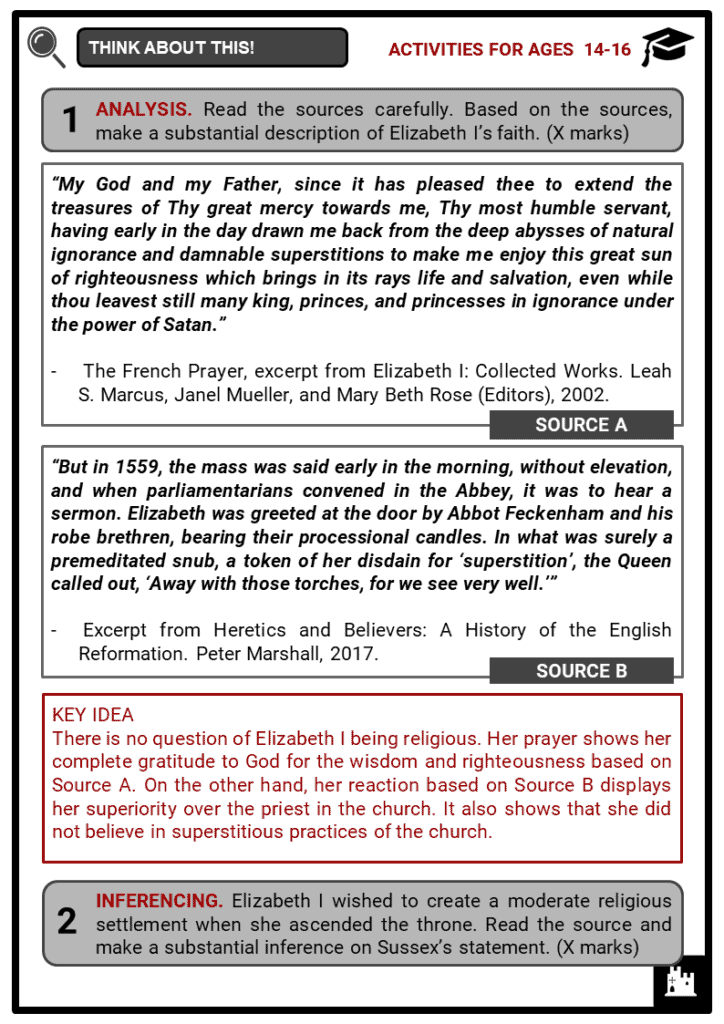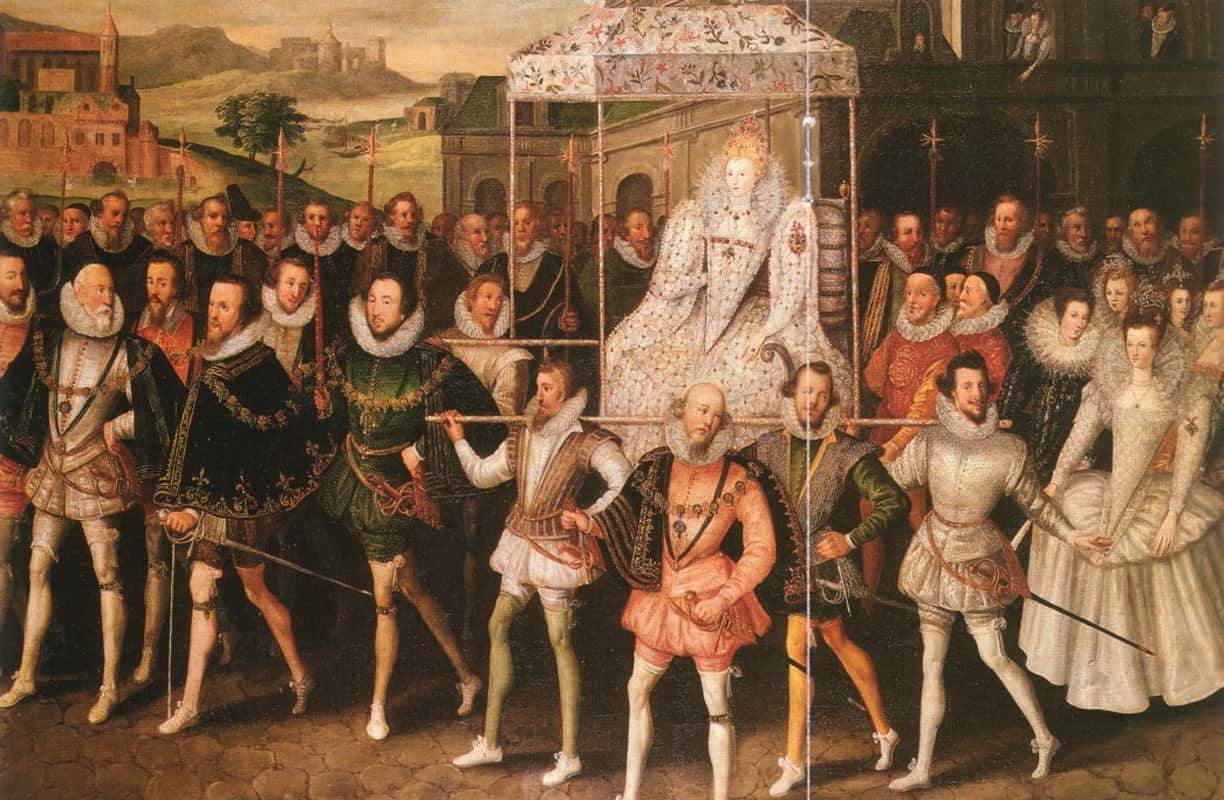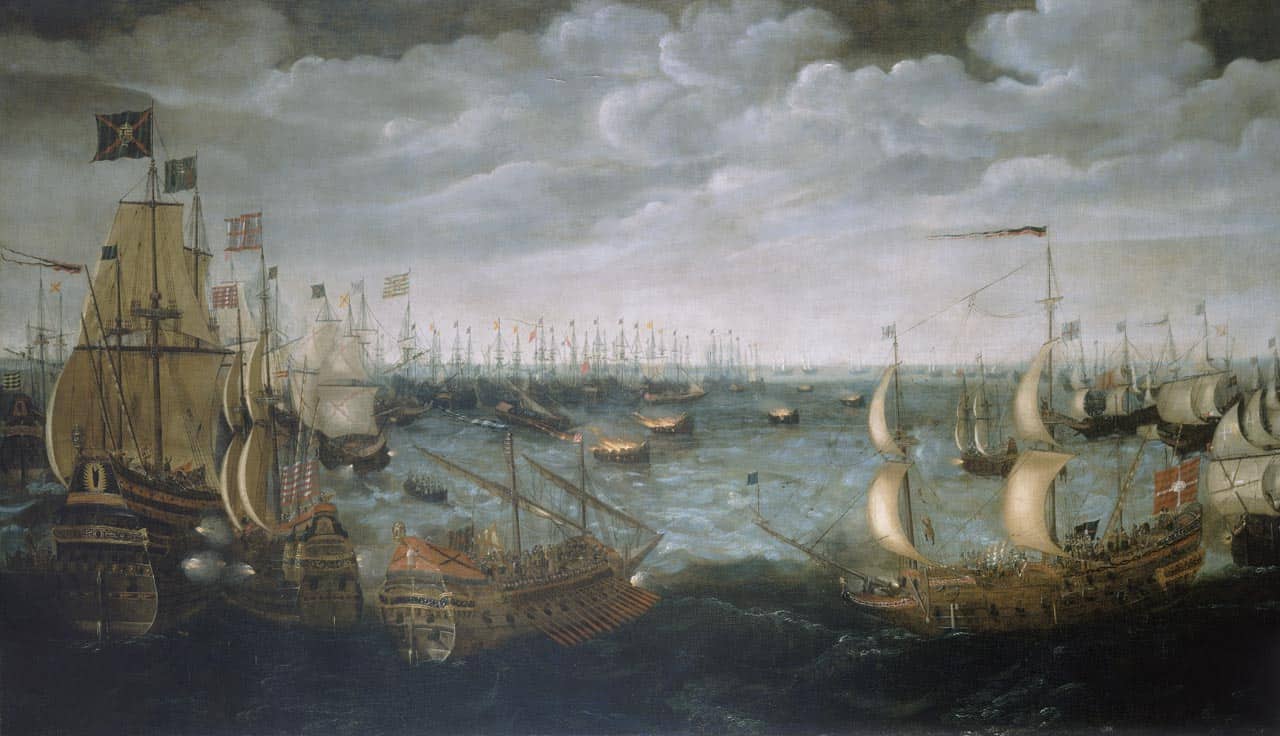Download Elizabeth I and Catholic Church Worksheets
Do you want to save dozens of hours in time? Get your evenings and weekends back? Be able to teach Elizabeth I and Catholic Church to your students?
Our worksheet bundle includes a fact file and printable worksheets and student activities. Perfect for both the classroom and homeschooling!
Table of Contents
Add a header to begin generating the table of contents
Summary
- The Ascension of Elizabeth I and the Religious Settlement
- The Marriage Question
- The Catholic Threat
- The Spanish Armada and the English Offensive
Key Facts And Information
Let’s know more about Elizabeth I and Catholic Church!
- Elizabeth I reintroduced Protestantism and reaffirmed England’s supremacy over the Papal States upon ascending the throne after the death of Mary I. Her moderate religious settlement led to a compromise to appease both the Catholics and the radical Protestants. Her reign was flooded with murder attempts against her, sanctioned by the Church of Rome and aided by Spain, to establish her cousin Catholic Mary, Queen of Scots to the English throne.
- Mary’s implication in the assassination plots resulted in her execution, which ultimately launched Spain, one of the greatest European Catholic powers, to make an ambitious attempt to conquer England with its invincible Armada and to bring back Catholicism to the country.
The Ascension of Elizabeth I and the Religious Settlement
- England was extremely divided between the Catholics and Protestants when Mary I died in 1558. Following the Third Succession Act, Elizabeth ascended the throne at the age of twenty-five and was welcomed as queen in England amidst the state of anxiety in the country over the perceived Catholic threat.
- Upon the coronation of Elizabeth I in January 1559, the first Parliament of her reign took up the matter of a new religious settlement.
- Wishing to proceed cautiously and conservatively, the queen proved ready to separate the English church once more from Rome and the papacy after the reign of her half-sister, Mary, who restored Roman Catholicism as the country’s religion and the Pope as the head of the church in an attempt to reverse the English Reformation.
- When the House of Commons passed the bill of supremacy that would have established the queen as the head of the church, the House of Lords rejected the act with a Catholic majority.
- The Parliament reconvened and the revised Act of Supremacy and the Act of Uniformity were passed in 1559.
- The revised Act of Supremacy maintained the abolishment of papal supremacy and defined Elizabeth as the Supreme Governor of the Church of England.
- The Act of Uniformity 1559 restored the modified version of the 1552 English Prayer Book, which allowed two interpretations of communion, one Catholic and one Protestant.
- The queen personally wished to create a moderate religious settlement, favouring an episcopal organisation of the church and a high church service.
- In contrast, the House of Commons was persistent for an exhaustive radical reform.
- A compromise was reached in the end.
- The religious settlement during the Elizabethan era has formed the character of the Anglican Church that can be witnessed today: it was a significant achievement of the young queen.
- However, the reign of Elizabeth I led to two wings of discontentment, one Catholic, the other Puritan.
- Since Elizabeth was the last of the Tudors, the security of England’s Protestant future was the chief concern of statesmen and the Parliament.
The Marriage Question
- During Elizabeth’s reign, it was expected of her to marry but the choice of husband was difficult. She considered several suitors but never proceeded to marriage, which would have offered the chance of an heir.
- Apart from her personal preferences, marriage proved impractical for the queen.
- She remained England’s virgin queen through both choice and politics, and claimed that she was wedded to her people.
- The pressure to marry was based on settling the succession to the throne through an heir to prevent the Catholic Mary Queen of Scots, who had the strongest claim after the Tudors.
- Elizabeth was practically alone in her perilous decision to leave the succession unsettled. Her obstinacy led to conflict with Parliament.
The Catholic Threat
- The revolts against Mary of Guise, the French regent, who was ruling for her daughter Mary, Queen Consort of France as well as Queen Regnant of Scotland, signalled the arrival of Reformation in Scotland in 1559.
- Elizabeth had to intervene and helped the rebels force out the French.
- Elizabeth thus protected England against potential enemies and formulated her long-term policy of supporting the Protestant party in Scotland.
- Similarly in 1562, she had to intervene in France in support of the rebellious Huguenots (Protestant) party, and later in the Netherlands, in support of the native Protestant rebels against Philip II of Spain.
- Mary Queen of Scots returned to Scotland after the death of her husband, Francis II, in 1561.
- This brought complication to the relations between the two queens.
- Unlike Elizabeth, Mary let her emotions affect her decision-making and governing of policies.
- Finally, after the murder of her second husband Henry Stuart, Lord Darnley, she was dethroned and imprisoned.
- When her army was defeated and her cause was lost, she escaped from prison and fled across the border to England.
- Mary Queen of Scots’ return to England in May 1568 eventually caused her detention by the English government.
- She was nearest to descent to the English throne after the Tudors and the English Roman Catholics claimed that she was the rightful queen, arguing that Elizabeth was the illegitimate daughter of Henry VIII.
- Mary’s presence became the focus for Catholic and non-religious discontent: a rebellion emerged in the north of England in 1569 supported by the Duke of Norfolk.
- This rebellion was defeated and 750 of them were executed under the queen’s order.
- It was then followed by Pope Pius V’s excommunication of Elizabeth in February 1570.
- Regnan in Excelsis was a bull issued by Pope Pius V and declared Elizabeth I as a heretic and “the pretended Queen of England and the servant of crime".
- Whilst Protestants had left England under Mary Tudor, Catholics fled abroad under Elizabeth.
- Catholic youths who were educated and trained in the seminaries founded on the continent were sent back to England as missionaries.
- Whilst the work of these missionaries was focused on religion, it was politically subversive and treasonable.
- With secular help from Spain and the Guise party in France, the papacy aimed to overthrow Elizabeth and to establish Mary, Queen of Scots on the throne.
- In response, the queen’s ministers and Parliament demanded severe penal laws against Catholics and Protestant nonconformists, especially priests from foreign seminaries.
- On the other hand, the queen constantly intervened to alter the penal laws and make them less intrusive.
- Her ministers and parliamentarians also sought to paralyse Catholic plans by executing Mary.
- When Mary’s involvement in the Ridolfi Plot was exposed in 1572, they pressed for a bill of attainder against her.
- Elizabeth undoubtedly saved Mary from execution when the queen forbade her ministers to proceed with the bill and to remove Mary’s right to the English succession.
- Ridolfi Plot was planned by a Florentine banker and ardent Catholic, Robert Ridolfi, to assassinate Elizabeth I in favour of Mary Queen of Scots.
- The evident Catholic threat became most threatening in the 1580s.
- Pope Gregory XIII proclaimed that ridding the world of the heretic queen would not be a sin.
- In 1580, Jesuits strengthened their missionary effort by reinforcing the ranks of seminary priests.
- In that same year, Spain consolidated its power as the champion of Catholicism when it absorbed Portugal.
- Elizabeth’s continued support for the Dutch revolt against Spain, and the attacks of English seamen, such as Sir Francis Drake and Sir John Hawkins, on the Spanish colonies, worsened the conflict in which each was the champion of an opposing creed.
- The delays in the Catholic plans for the invasion of England drove the papacy to sanction the plots for Elizabeth’s assassination.
- In 1584, the discovery of another rebellion and murder attempt, Throckmorton Plot, came with the news of the assassination of William of Orange (William the Silent), who was the main leader of the Dutch Revolts, by a Catholic supporter of Philip II of Spain.
- The Bond of Association was used by Protestants throughout England to employ lynch law against Mary Queen of Scots if any attempt were made against their own queen.
- Elizabeth intervened again in the Parliament that autumn, in defence of Mary.
- Throckmorton Plot was another assassination plot by Sir Francis Throckmorton, cousin of Bess Throckmorton, lady in waiting to Queen Elizabeth.
- Bond of Association obliged its signatories to execute any person who attempted to assassinate the queen and usurp the throne, successfully or otherwise.
- In the autumn of 1585, the death of William the Silent forced Elizabeth to send an English army to the Dutch’s aid, under the Earl of Leicester.
- The queen’s open intervention was tantamount to an act of war.
- The Babington Plot was then uncovered in 1586, with Mary’s connivance to the murder attempt.
- The conspirators of the Babington Plot were Anthony Babington and John Ballard, who planned to rescue Mary Queen of Scots from house arrest and dethrone Elizabeth I.
- Under an act of Parliament that was passed in 1584-1585, Mary was tried and condemned to death.
- Parliament convened and its unanimous decision of Mary’s execution left the queen with little choice.
- The queen would have preferred to let Mary be put to death by private persons.
- On 8 February 1587, Mary was executed and the queen was distressed when she learnt that her councillors forwarded her signature of the warrant without further authority.
The Spanish Armada and the English Offensive
- Mary’s death further stimulated the Catholic enterprise against England, sponsored by the Pope and executed by Spain.
- Sir Francis Drake’s destruction of Spanish shipping at Càdiz in 1587 delayed the attack initially, until the Spanish Armada sailed in the summer of 1584.
- King Philip II put together 130 ships, thirty thousand men coming from Iberia, and thirty thousand more from the Netherlands; his objective was to conquer and restore Catholicism in England.
- The invincible Armada aimed to overpower the English fleet and secure the landing of a Spanish army from the Netherlands but it was ironically defeated.
- The Protestant wind dispersed and forced the Armada to return to Spain by sailing around Scotland and Ireland.
- The Spanish fleet lost heavily by storm and shipwreck.
- It was during the crisis when Elizabeth made her famous speech in Tilbury defying Spain, whose invasion was momentarily expected.
- Though war between Spain and England was never formally declared, open conflict between the two countries continued, with the English fleet and private adventures making occasional forays against Spain and its dominions.
- In 1589, Elizabeth found herself drawn into further commitments when Henry III of France was assassinated.
- The French Catholic League, aided by Spain, resisted the accession of the rightful heir, Henry IV, who was the leader of the Huguenot Party.
- Elizabeth sent military support to France, first in 1589 under Lord Willoughby, again in 1590 under John Norreys, and lastly in 1591 under Robert Devereux, second Earl of Essex.
- The result of these campaigns was just dismal and Henry IV abandoned the siege, accomplishing nothing.
- Spain succeeded under Alexander Farnese, Duke of Parma. Henry IV was eventually crowned King of France when he converted to the Catholic faith.
- After two decades of Catholic plots against Queen Elizabeth I and the Spanish attacks against her cause, most of the people accepted the Church of England as the national church by 1590.
Image sources:
[1.] https://upload.wikimedia.org/wikipedia/commons/4/45/Elizabeth_I%2C_Procession_Portrait..jpg
[3.] https://upload.wikimedia.org/wikipedia/commons/6/69/Execution-of-Mary-Queen-of-Scots.jpg
[4.] https://upload.wikimedia.org/wikipedia/commons/d/d0/Spanish_Armada_fireships.jpg

